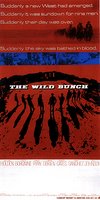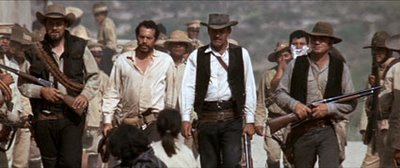The Wild Bunch
 The bloody action in Sam Peckinpah's The Wild Bunch takes place either side of the US/Mexican border--and in one memorable scene, on a bridge directly on the border itself--as a new nation is being born to the South, and an old one is dying to the North.
The bloody action in Sam Peckinpah's The Wild Bunch takes place either side of the US/Mexican border--and in one memorable scene, on a bridge directly on the border itself--as a new nation is being born to the South, and an old one is dying to the North.The film depicts, therefore, a moment of transition. All such transitions are times of violence: the painful uprooting of old traditions and the hard-fought emergence of the new. More violence is around the corner, as the film indicates, with World War One ushering in a global realignment of forces, and the definitive mechanization of death. This is foreshadowed by the use, here, of an automobile as instrument of torture, and a machine gun as agent of unparalleled, indiscriminate mayhem.
At first sight the border between North and South may appear blurred, but only at first sight, or so suggests the Wild Bunch's one Mexican. "Mexico lindo," exclaims the character Angel as the group arrive at the Rio Grande. "Just seems like more Texas as far as I'm concerned," replies one of his partners. "Then you have no eyes," responds Angel.
But which Mexico is this that they are entering? The Mexico of sleepy villages and welcoming indigenous peasants, or the Mexico torn apart by civil war, where Angel finds his father has been killed and his girlfriend taken by Federal troops? "In Mexico," a village elder tells them, "these are the years of sadness." Indeed, unlike so many other movies of the Mexican Revolution (and The Wild Bunch surely is one of these), we catch nor more than a glimpse of the revolutionaries themselves, or the desire for a liberating modernity that they incarnate.
It's hardly a coincidence that shooting wrapped at the end of June 1968. The the Mexican student movement was about to unfold, which was abruptly terminated in the October massacre at Tlatelolco, definitively putting an end to the myth of a beneficent Revolutionary state. The Wild Bunch is heavy with disillusion about the prospects for a liberatory violence: modernization has put paid to all such dreams, whether in Mexico, Vietnam, or the USA itself.
Not that the film allows any sentimantal nostalgia for a more heroic past, either. The leader of the outlaw band that is the wild bunch, one Pike Bishop, is haunted by the string of betrayals and broken alliances that he has left behind him in his life of crime. Or rather, they are not so much left behind as catching up on him as his former comrade, Deke Thornton, is on his trail in the reluctant pay of the railroad bosses.
But in this moment of "interregnum", before the old has fully died and while the shape of the new is yet uncertain, Bishop sees a brief chance for something like redemption. Angel, whose name is always here pronounced by his partners in anglicized fashion to underline his association with the divine, siphons off a case of stolen weaponry for his villagers' defensive cause. Captured by the Mexican General Mapache, he is at first left to his fate by Bishop and his gang. But then, with the simple words "Let's go," Pike leads them in the famous walk back to the general's encampment, in a gesture that they all know to be suicidal, but ultimately honourable.

The Wild Bunch opens and closes with laughter. It opens with the rather sinister sniggers of small children as they cast scorpions to deadly ants, shortly to set fire to the lot in their glee at torture and destruction. It closes with a series of flashbacks of the various members of the wild bunch, now all dead, laughing and loving some aspect of their precarious lives.
But the most significant laughter comes in the still small moment of quiet around which this endlessly busy, endlessly violent action movie turns. With their enemies all around, with their partner the Mexican Angel sacrificed in front of them, and just after they have shot dead General Mapache, Bishop and his three remaining comrades find themselves in a sudden pause, at the eye of the storm. They look at each other and begin to smile and laugh. Not, as Tim Dirks suggests, because they think "for an instant, they just might succeed." But because they affirm the interregnum itself, the moment at which everything is possible only in that nothing is possible.
We can't go on. We must go on.
And perhaps the most famous massacre in film history follows on immediately.
